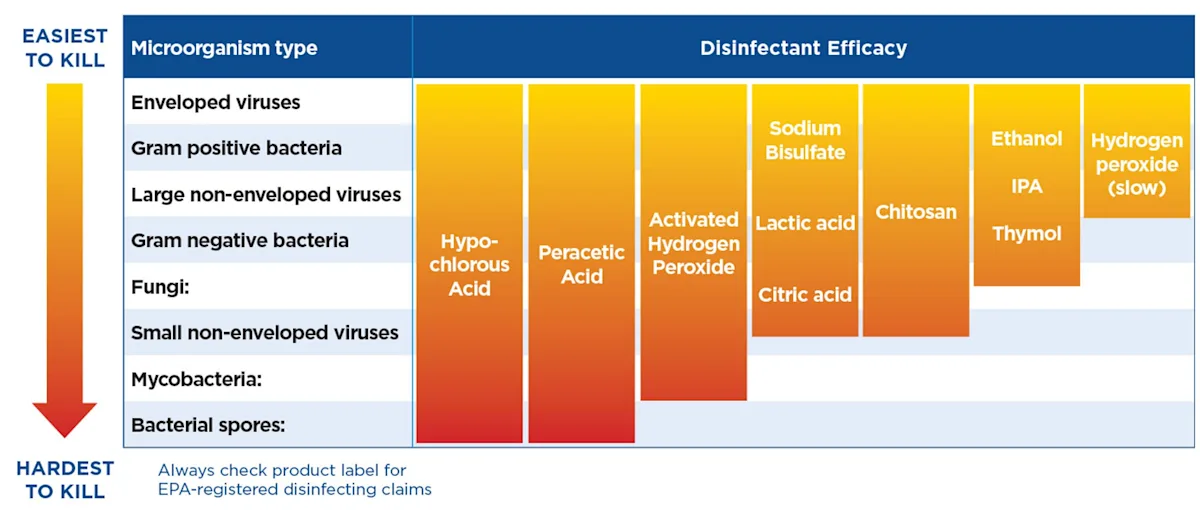Dispelling Myths About Safer & Sustainable Cleaners

Demand for Green Cleaners and Disinfectants Is Increasing
Following an exponential increase in the use of disposable materials and cleaning and disinfecting products during the COVID-19 pandemic, many look to the next few years with sustainability in mind. A survey found that during the pandemic, 85% of people were thinking about sustainability either the same or more than before the pandemic.1
While it may appear that this is new, the push from consumers for sustainable and safer options has been increasing steadily over the past few decades.
In this first blog in a three-part series of articles on safer and sustainable disinfectants, I want to start by dispelling some myths about greener disinfecting for everyone from facility managers to product users.
Myth #1: “Green” Disinfecting Products Don’t Work as Well as Traditional Counterparts
Despite the widespread notion that it is impossible to make a green disinfectant, in the 1990s the EPA established a certification for cleaners and disinfectants deemed safer for human health and the environment while still proving efficacy against microorganisms using the same test methods as traditional products. Today, there are more than 2,000 products certified under the Safer Choice and Design for the Environment labels.
One key difference between traditional disinfectants and safer and sustainable options lies in the type of active ingredients that they use. There are specific allowable active ingredients for greener disinfecting products based on their lifecycle impacts on the environment and safety for the end user. Generally, safer and sustainable active ingredients for disinfectants should fall under the lower EPA toxicity classes and have minimal impact on the environment in the waste stream. See the chart below for examples of safer and more sustainable active ingredients and the types of pathogens they may be able to kill. As with any disinfectant, always check the master label for approved kill claims and remember that the entire formulation makes the product.

Myth #2: “Green” Products Are Not Actually Better for the Environment
This myth has a storied past. At one time, product manufacturers and marketers made broad claims about their product’s environmental benefits or sustainability that, unfortunately, were without merit and were misunderstood by customers about the benefits.2 This led to the widely held impression that green products don’t live up to the hype. This has been especially true for products marketed as green cleaners and disinfectants, where claims about biodegradability or safety are accompanied by products that do not work as well as their traditional counterparts.
This marketing practice was labeled “Greenwashing” and became such a big problem that the Federal Trade Commission (FTC) developed the Green Guides3 — a guide for marketers about how to make substantiated claims about environmental benefit and safety that would not mislead the consumer. Since the first release of the Green Guides more than 20 years ago, the FTC has also introduced significant enforcement actions against companies making unsubstantiated claims of environmental or safety benefit, and they have brought over 100 of these enforcement actions against companies for making false claims.
Today, products must provide context and information to demonstrate the benefits they claim. For example, a company claiming that a product has low or no Volatile Organic Compounds (VOCs) should have testing to prove this and should provide context for how the consumer can obtain the safety benefit and reduced health risks of lower VOCs. As another example, a product with claims to be biodegradable must show that it is biodegradable under the circumstances that it is normally disposed: a disinfectant wipe that is biodegradable in a soil-burial test but ends up in a landfill or an incinerator based on normal consumer usage, is not actually biodegradable.
Myth #3: “Green” Products Are Not Actually Safer for the End User
All disinfectants registered by the EPA are safe to use as directed. Every product registered with the EPA is required to submit safety information and required personal protective equipment recommendations to ensure the safety of the end user with the product.
A greener cleaner or disinfectant is expected to fall under the lower end of risk to end users under EPA criteria (toxicity ratings of either III or IV), and for products sold as concentrates, there are additional expectations that the product is packaged in a way to minimize accidental contact with the end user. While not always true, safer and sustainable disinfectants may often be food contact safe, may be safe to use without any personal protective equipment, and are considered safer to use around children, pets, and plants.
Next in the Series – Third-Party Certifications of Green Cleaners and Disinfectants
In my next blog, I will talk about the key third party certifications — EPA Safer Choice, EPA Design for the Environment, GreenSeal, and Ecologo — for safer and sustainable cleaners and disinfectants. A third-party certification is a quick way to know exactly which environmental and safety benefits a product has.
References
^1. Cumbers, J. (2021, April 20). Despite coronavirus, 85% of Americans are thinking about sustainability as much as or more than ever. Forbes. Retrieved May 2, 2022, from https://www.forbes.com/sites/johncumbers/2020/07/29/despite-coronavirus-new-survey-shows-56-of-americans-are-thinking-about-sustainability-more-than-ever/?sh=6e5103704076
2. Green guides. Federal Trade Commission. (July 2021) Retrieved May 4, 2022, from https://www.ftc.gov/news-events/topics/truth-advertising/green-guides
3. Federal Trade Commission Guide for the Use of Environmental Marketing Claims. (n.d.). Retrieved May 2, 2022, from https://www.ftc.gov/sites/default/files/documents/federal_register_notices/guides-use-environmental-marketing-claims-green-guides/greenguidesfrn.pdf^
















